Submitted by Lisa Graves on
What is Energy In Depth, really? EID describes itself as "a research, education and public outreach campaign focused on getting the facts out" about hydraulic fracturing, widely known as "fracking." It's a website created by a trade group for the gas industry -- the "Independent Petroleum Association of America" (IPAA) -- and a public relations firm.
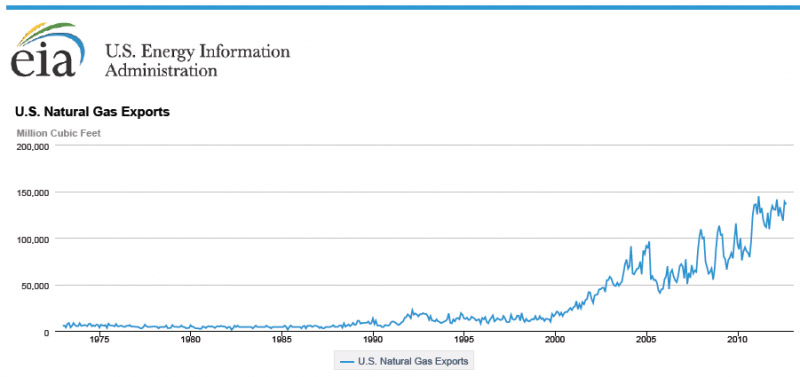 In short, IPAA/EID is a PR operation for the industry's multi-billion dollar financial interests in "unconventional" drilling for what is popularly known as "natural gas." Although this expanded drilling is often described as essential to our "national security," the Center for Media and Democracy/PRWatch has shown that the industry is increasingly exporting gas to be sold in other countries. IPAA/EID's PR efforts pay special attention to the "Marcellus shale" gas that lies deep beneath the surface in Pennsylvania, Ohio, New York, and neighboring states, which constitutes a lucrative market for multi-national firms and their domestic counter-parts to exploit.
In short, IPAA/EID is a PR operation for the industry's multi-billion dollar financial interests in "unconventional" drilling for what is popularly known as "natural gas." Although this expanded drilling is often described as essential to our "national security," the Center for Media and Democracy/PRWatch has shown that the industry is increasingly exporting gas to be sold in other countries. IPAA/EID's PR efforts pay special attention to the "Marcellus shale" gas that lies deep beneath the surface in Pennsylvania, Ohio, New York, and neighboring states, which constitutes a lucrative market for multi-national firms and their domestic counter-parts to exploit.
IPAA/EID's "about" page says its "supporting members" are state associations of gas producers. It displays their logos, instead of the global corporations that launched it.
What the logos cloak -- in classic PR sleight of hand -- are the larger interests behind the IPAA/EID operation.
It has been described by some in the press as merely a "pro-drilling group" (in contrast with "anti-drilling" groups or citizens), but here's how IPAA described EID in a leaked internal memo from 2009, obtained by DeSmogBlog last year. IPAA privately told its allies that EID was its new "online resource center to combat new environmental regulations," created with funding from Shell, BP, Chevron, and more.
In other words, IPAA/EID is more accurately described as a front group launched by global gas companies in order to fight a public relations battle against new environmental protections on fracking.
Behind IPAA/EID: Some of the Biggest Corporations in the World
The leaked IPAA memo reveals that the EID campaign was created through the "financial commitments" of some of the biggest companies (with some of the worst environmental records) on the planet. To wit:
- Shell, which is the second largest company in the world in terms of revenue, with income of almost a half a trillion dollars in 2011: $470 billion, just behind Exxon. Royal Dutch Shell is a Dutch company registered in London. In 2010, Shell bought "East Resources," which had gas holdings in Pennsylvania and nearby, for $4.7 billion. Shell's environmental record includes the largest fresh water spill of oil in the world (in 1999 in Argentina), a major oil spill near Alaska in 1988, and numerous spills in the Niger delta in Africa. (East Resources' founder, Terry Pegula, and his wife gave at least $300,000 to Tom Corbett's campaign for governor of Pennsylvania.)
- BP, which is the sixth largest company in the world in terms of revenue, with revenue of $375 billion in 2011. BP is a British oil and gas company, which took over two US companies, Amoco and ARCO (Atlantic Richfield Company) about a decade ago. Last month, BP and three of its employees were indicted on criminal charges, including manslaughter and obstruction of Congress, in connection with the Deepwater Horizon oil drilling disaster in the Gulf of Mexico, and it also agreed to pay a $4 billion fine related to the disaster. (And, although many are unaware of it, BP's decisions also made the Exxon Valdez disaster worse.)
- Chevron, which is a U.S. company that is the tenth largest in the world in terms of revenue, with income of $253 billion in 2011. Last year, Chevron obtained gas leases for over a million acres, plus hundreds of thousands of acres of development rights, from smaller companies like Chief Oil & Gas. Chevron and other companies have been sued for damaging our environment through the use of the MTBE gasoline additive that has contaminated water and soil. (Chief's CEO, Trevor Rees-Jones, has been active in politics, giving at least two million dollars to Karl Rove's Crossroads operations.)
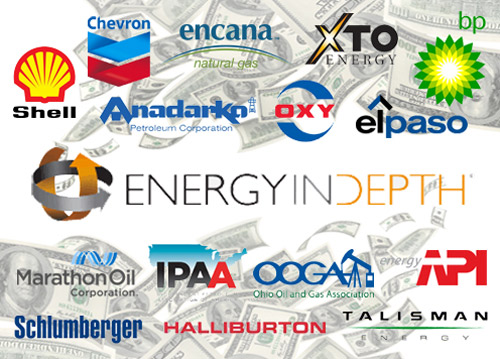 Another corporation whose funding helped launch IPAA/EID is XTO Energy, which became a subsidiary of ExxonMobil in 2010. XTO was a billion-dollar Fortune 500 company that became the largest producer of natural gas in the US after it acquired Hunt Petroleum for $4.2 billion in 2008. ExxonMobil is the largest company in the world, with revenue of $486 billion in 2011. (Exxon's environmental record includes the notorious Exxon Valdez disaster, and it has spent millions of dollars over the years funding groups that front industry propaganda, as documented by Greenpeace.)
Another corporation whose funding helped launch IPAA/EID is XTO Energy, which became a subsidiary of ExxonMobil in 2010. XTO was a billion-dollar Fortune 500 company that became the largest producer of natural gas in the US after it acquired Hunt Petroleum for $4.2 billion in 2008. ExxonMobil is the largest company in the world, with revenue of $486 billion in 2011. (Exxon's environmental record includes the notorious Exxon Valdez disaster, and it has spent millions of dollars over the years funding groups that front industry propaganda, as documented by Greenpeace.)
Other corporations whose funding helped launch IPAA/EID include two Canadian gas companies, EnCana and Talisman, plus Occidental Petroleum (California's largest gas producer) and Marathon (now Marathon Oil Corporation, which also has major interests in gas).
Other IPAA/EID funders include Schlumberger, the world's largest petroleum field services company, which began long ago as a French firm but has been headquartered in Texas for many years. The IPAA memo also lists Halliburton, one of the world's largest oil field services companies, which helped pioneer "proprietary" fracking fluids and whose Energy Services Group is involved in supporting fracking activities. (Halliburton recently settled a criminal corruption case alleging bribery by its then-CEO, Dick Cheney, and a former subsidiary, Kellogg, Brown, and Root (KBR), in connection with its natural gas operations in Nigeria.)
IPAA/EID was also launched with the financial support of the American Petroleum Institute (API), a non-profit trade group that represents many of these same interests. API had revenue of over $181 million in 2010 from "membership dues" from corporations and other sources, and it spent one-third of its income on the Edelman PR firm. According to its IRS Form "990," API gave nearly $200,000 to IPAA for "energy education" between 2008 and 2010.
Another IPAA/EID funder mentioned in the IPAA memo is Anadarko Petroleum Company, which has gas wells in Pennsylvania and Texas. Anadarko owned a 25% stake in the Deepwater Horizon, with BP, Halliburton, and others.
 Anadarko made the news on fracking last year after its Public Affairs Manager, Matt Carmichael, promoted the use of military "psyops" in Pennsylvania communities to combat "an insurgency" of citizens concerned about fracking (as recorded by Sharon Wilson of the Oil and Gas Accountability Project). IPAA/EID's Chris Tucker tried to spin those comments by claiming they were meant as a joke, despite all evidence to the contrary. Carmichael is a former senior communications guy for KBR, which was a subsidiary of war contractor Halliburton.
Anadarko made the news on fracking last year after its Public Affairs Manager, Matt Carmichael, promoted the use of military "psyops" in Pennsylvania communities to combat "an insurgency" of citizens concerned about fracking (as recorded by Sharon Wilson of the Oil and Gas Accountability Project). IPAA/EID's Chris Tucker tried to spin those comments by claiming they were meant as a joke, despite all evidence to the contrary. Carmichael is a former senior communications guy for KBR, which was a subsidiary of war contractor Halliburton.
None of these major for-profit companies or API -- the financial underwriters that launched IPAA/EID -- are listed on the campaign's website or in its description of its supporters.
IPAA/EID Targets the Park Foundation While Keeping Its Corporate Funders Secret
IPAA/EID has been on the attack against critics of the fracking that is so lucrative for its secretive financial backers.
Here's a recent example of its disinformation: the Capital Research Center (CRC) -- itself part of the CEO-fueled echo chamber -- quoted EID's flack Tom Shepstone this month implying that the Park Foundation spent more than $17 million helping to oppose fracking in just one year. Wrote CRC: "In 2009, the Park Foundation had net assets of $246 million and spent $23 million, which included $17.6 million in grants and contributions to green groups opposed to fracking, according to Shepstone," a Pennsylvanian whose official title is "Campaign Director" for EID's "Northeast Marcellus Initiative."
But, as reported earlier this year, the Park Foundation's public filings show that only a fraction of that amount was spent on grants for projects to educate the public about fracking. The total for 2009 was approximately $700,000, which is 1/25th of what Shepstone claimed. In contrast, the industry's biggest trade group, API, spends over a $180 million a year on its entire budget, including tens of millions of dollars on PR.
This is not the first time Shepstone has had trouble with numbers. In 2000, a court approved his federal bankruptcy after he and his wife racked up more than $725,000 in debt as compared with their assets -- described as a house on five acres (valued at $125,000), a new car loan for a Chevy S-10 Blazer, and $200 worth of clothes, although he attested that they made almost $90,000 annually a few years earlier -- with some personal debt including some debt related to his businesses, described as "Shepstone Management Corp." in Honesdale and "North Country Farm and Gardens Corp.," at 160 Roosevelt Highway in Waymart. They were also subject to an IRS tax lien for more than $20,000 in unpaid taxes attributed to "Tom Shepstake" and his wife in 1996, a claim that was later settled. Americans do, of course, have the right to declare bankruptcy when their financial calculations go awry and get a second chance, like Shepstone.
CRC used Shepstone's recent math on Park to buttress the absurd thesis that "Environmentalists often depict themselves as scrappy underdogs fighting the power of entrenched special interests. But the case of the Marcellus Shale -- and the untold energy resources that could be recovered safely by new drilling technology such as fracking -- pits 'the little guy' against powerful 'green' forces such as the Park Foundation and the Natural Resources Defense Council."
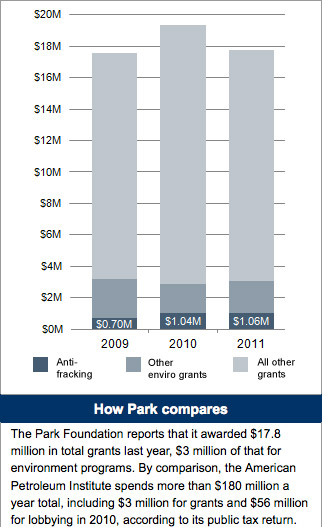 Like IPAA/EID, CRC keeps many of its big funders secret, although foundation filings show that its funders have included the Charles G. Koch Charitable Foundation, the family foundation of the CEO of the multi-billion dollar Koch Industries -- which in turn is led by Charles and his brother David Koch and is one of the richest privately held gas, oil, and chemical companies in the world. Koch Industries has reaped undisclosed profits from ventures benefiting from expanded fracking, such as from the lower cost of the natural gas used as a feeder to make its fertilizer by Koch Nitrogen, one of the Koch companies.
Like IPAA/EID, CRC keeps many of its big funders secret, although foundation filings show that its funders have included the Charles G. Koch Charitable Foundation, the family foundation of the CEO of the multi-billion dollar Koch Industries -- which in turn is led by Charles and his brother David Koch and is one of the richest privately held gas, oil, and chemical companies in the world. Koch Industries has reaped undisclosed profits from ventures benefiting from expanded fracking, such as from the lower cost of the natural gas used as a feeder to make its fertilizer by Koch Nitrogen, one of the Koch companies.
Only in the distorted worldview of CRC does an industry made up of some of the most profitable corporations in the history of the world -- ExxonMobil, Shell, BP, Chevron, Koch Industries, Halliburton, and more -- get portrayed as "the little guy" fighting for fracking against a putative Goliath in the form of the Park Foundation.
In contrast to Shepstone's dramatically inflated figures, "[s]ince 2008, the foundation has given at least $2.8 million to groups and publications fighting shale drilling," according to EnergyWire. That cumulative spending is less than a quarter of what Shepstone claimed the Park Foundation spent in one year alone.
But such efforts to discredit the growing grassroots movement of citizens concerned about fracking -- such as by insinuating that it's all about "buckets of money" from Park, according to Shepstone -- are particularly deceptive when made by operations like CRC and IPAA/EID, which don't disclose the identities of their major funders such as the for-profit businesses that paved the way for EID's campaign.
Uncloaking the Revenue Stream of IPAA's PR Machine
Because EID was created as an operation within the IPAA, it does not file its own IRS Form 990 tax form, and so its true revenues and expenses are hidden from public view.
What is known is that, in 2010, IPAA had revenue of more than $8 million ($8,714,606) and spent almost the same. This revenue and expense rate is relatively consistent with the two preceding years.
IPAA is described as a trade association organized under 501(c)(6) of the Internal Revenue Code. It shares space and staff with its "IPAA Educational Foundation" (IPAAEF), a 501(c)(3) non-profit organization, which means that in general contributions to the latter can be counted as a charitable tax deduction by its donors. IPAAEF has annual revenue of almost a half million dollars a year, and it reports paying a "management fee" to IPAA of a little more than $200,000 a year. IPAAEF describes its activities as including grants to fund students "as interns at petroleum companies." According to its Form 990, one of IPAAEF's main activities each year appears to be its "Wildcatters Ball," which cost $227,270 in 2010. IPAA also hosts an annual golf tournament that costs almost $200,000.
IPAA has assets worth over $8 million, as of the end of 2010. It invested about $6.5 million of this in publicly traded securities. It did not disclose the identities of these stocks or bonds and whether any of its investments are related to the gas industry. In 2010, it reported investment income of about $215,000.
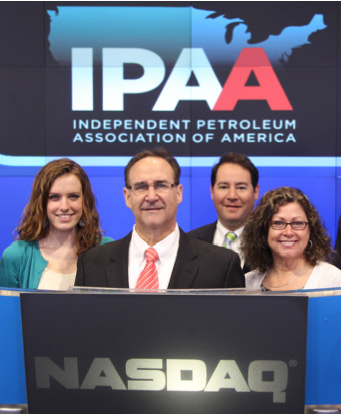 IPAA was also listed in a publicly filed licensing agreement in 2002 between the FBR Family of Funds and the "IPAA Energy Index." According to that agreement, "the FBR/IPAA Energy Index Fund is a series of a registered open-end management investment company whose objective is to track the price and yield performance of publicly-traded common stocks of companies represented by the IPAA Energy Index. The Fund is a no-load mutual fund, and its assets are invested by FBR Fund Advisers, Inc." There is little public information about what happened under that agreement or whether or not IPAA has other relationships with investment funds or groups speculating on fracking. It has showcased presentations on capital investment in fracking featuring information from investment bankers like Goldman Sachs.
IPAA was also listed in a publicly filed licensing agreement in 2002 between the FBR Family of Funds and the "IPAA Energy Index." According to that agreement, "the FBR/IPAA Energy Index Fund is a series of a registered open-end management investment company whose objective is to track the price and yield performance of publicly-traded common stocks of companies represented by the IPAA Energy Index. The Fund is a no-load mutual fund, and its assets are invested by FBR Fund Advisers, Inc." There is little public information about what happened under that agreement or whether or not IPAA has other relationships with investment funds or groups speculating on fracking. It has showcased presentations on capital investment in fracking featuring information from investment bankers like Goldman Sachs.
As a non-profit organization, IPAA's tax benefits under the federal tax code are predicated on it not being "organized for profit and no part of the net earnings of which [can] inure[] to the benefit of any private shareholder or individual." There is no public information indicating whether or not any of its employees invested in the FBR Fund or other energy funds, stocks or other investment vehicles, or whether it has any policy barring its employees from such investments or land speculation in fracking regions. It has no published conflict-of-interest policy on this issue, but there is no legal requirement that it adopt one (other than for conflicts involving payments from the non-profit entity to people related to principals in the organization).
In 2010, IPAA received $3.8 million from membership dues and most of the remainder of its $8 million budget from program fees for nearly two dozen conferences a year. IPAA's annual dues for gas companies are calculated on a sliding scale based on the "Barrel of Oil Equivalents" (BOE) and range from $4,000 to $60,000 per year depending on whether a company's BOE is under 750,000 or more than 50 million BOE. By reference, Anadarko Petroleum, a funder of IPAA/EID that is described as one of the world's largest oil and gas exploration firms, "had production of 206 million BOE" as of 2008.
Companies that pay these dues can deduct 65% of them as business expenses; 35% of the dues are considered lobbying expenses. In 2010, IPAA reports that it spent $1.3 million on lobbying and political expenditures. IPAA also has a related "527"-type organization involved in political campaigns, called the "IPAA Wildcatters Fund," which had $542,639 in receipts in the run up to the 2012 elections. IPAA also told the IRS in 2010 that it had "joined forces with the Business Industry Political Action Committee," whose slogan used to be "Electing Business to Congress" and is now "Powering Business Political Success."
Who Leads IPAA/EID and for How Much?
The portion of IPAA's annual revenues or expenses that fund its EID campaign is not disclosed.
What is known is that in 2010, IPAA paid its president, Barrett (Barry) Russell, more than one-half million dollars in total compensation ($511,000 and a promise of health insurance for him and his wife for life). Russell was elected president of the IPAA in 2000. He also has seat on the board of the Business Industry Political Action Committee and the National Energy Education Development Project. He's been IPAA's "chief legal and financial officer since 1988 and an officer of IPAA's educational foundation since its inception." He previously worked for the EPA, and he also worked for consulting firms, such as Booz, Allen and Hamilton, specializing in mergers and acquisitions.
IPAA paid another nearly one million dollars in total compensation for its next five highest paid employees combined (who each earn over $200,000 a year). This list includes Lee Fuller and Jeff Eshelman, who are specifically listed on the EID website as part of the EID team.
Fuller, a chemical engineer, is IPAA's Vice President of Government Relations, and he is listed on the website as EID's "Executive Director." He began working for IPAA in 1998 after working as a lobbyist for the gas industry for 12 years following an eight-year job staffing the Senate Committee on Environment and Public Works, where he handled rules on drilling fluids, wells, and Superfund sites. Eshelman is also a Vice President for IPAA and has served as its spokesman for a number of years.
 In 2010, these and other IPAA executives got big raises, including a raise of more than $60,000 for the president. The salary increases for other IPAA executives that year ranged from $21,000 per year to $53,000 per year.
In 2010, these and other IPAA executives got big raises, including a raise of more than $60,000 for the president. The salary increases for other IPAA executives that year ranged from $21,000 per year to $53,000 per year.
There is no information in IPAA's 2010 public tax filings about what the 13 other staffers listed on its EID campaign website are paid per year because only the top highest paid staffers are required to be disclosed (and also some of the EID team are recent hires). There also appears to be no publicly posted conflict-of-interest rule in this field that would require the disclosure of any fracking-related stock or real property holdings that would benefit from limiting restrictions on fracking by any IPAA/EID team member.
Shining a Spotlight on the IPAA/EID Marcellus Team
According to the leaked memo from IPAA, EID's reason for being is to serve as a "major initiative to respond to . . . attacks" on fracking and amplify "coordinated messages." Although IPAA/EID's reach is nationwide, one area where it appears to be particularly aggressive is Pennsylvania, through the blogging and outreach of Tom Shepstone.
Shepstone is described as the Campaign Leader of the EID Marcellus team. Before joining IPAA/EID, Shepstone worked primarily as a consultant writing reports for towns about land planning, at taxpayer expense. Even before he became the gas industry's campaigner in the region, he was apparently recommending industry-friendly land use rules, such as including a so-called "right to mine" in recommendations, expressly urging towns not to interfere with the development of natural gas, and not including recommendations for extra setback distances from property lines for industrial activities versus other structures. Shepstone was previously an IACP certified planner, which has conflict-of-interest rules, but he has said that he stopped paying dues and was not dropped by the American Planning Association.
In the period between his bankruptcy and his public association with IPAA/EID last year, Shepstone was often quoted in the press with the description "local businessman." He also wrote online comments praising right-wing diatribes. For example, he gave the highest review to the book, "The Red Decade: the Classic Work on Communism in America During the Thirties," which he said provided "[g]reat insights for those who recognize we are reliving the 1930s," and showed how those with a "liberal/leftist" mindset are prone to be "manipulated by totalitarian thugs."
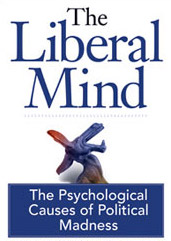 In another public review, Shepstone gave the highest marks to "The Liberal Mind: the Psychological Causes of Political Madness," which he said would help readers "completely understand how Obama thinks" and explains the president as well as Bill and Hillary Clinton "in their totality." He also claimed that reading this and Saul Alinsky's "Rules for Radicals" -- a favorite boogeyman of right-wing talk show hosts -- would help "predict" President Obama's actions. The "Liberal Mind" book endorsed by Shepstone actually claims repeatedly that embracing progressive values is a mental disorder that is "the product of psychopathology," which undermines "the ability of families to raise children to be self-reliant" and "threatens to destroy the West's greatest achievement: the American dream of civilized liberty."
In another public review, Shepstone gave the highest marks to "The Liberal Mind: the Psychological Causes of Political Madness," which he said would help readers "completely understand how Obama thinks" and explains the president as well as Bill and Hillary Clinton "in their totality." He also claimed that reading this and Saul Alinsky's "Rules for Radicals" -- a favorite boogeyman of right-wing talk show hosts -- would help "predict" President Obama's actions. The "Liberal Mind" book endorsed by Shepstone actually claims repeatedly that embracing progressive values is a mental disorder that is "the product of psychopathology," which undermines "the ability of families to raise children to be self-reliant" and "threatens to destroy the West's greatest achievement: the American dream of civilized liberty."
Given Shepstone's warm embrace of such fringe views, it is not entirely surprising that the IPAA/EID Marcellus website for the campaign he leads takes pains to try to score right-wing points in claiming that "the shale 'revolution' in the United States is impacting our 'friends' in Russia and Iran." It is also unsurprising that some of Shepstone's writings for IPAA/EID refer derisively to his fellow citizens exercising their fundamental First Amendment rights. To take a few recent examples of the tenor of his remarks, he put down an advocate asking serious and legitimate questions about the consequences of fracking in the community as an "aging activist seeking relevance in a modern world" and he also derided a community protest of 150 citizens as "a pathetic failure."
But, beyond his apparent animosity toward progressives and other concerned Americans, it is Shepstone's claims that are particularly astonishing. Here's a sampling of his disinformation sound bites:
- "Hydrofracking Improves Water Quality!" – When Shepstone made this claim at a public meeting, he was met with a spontaneous burst of laughter in disbelief, but he claimed it was true because more wells will be tested due to fracking than are currently monitored. In claiming fracking improves water quality, Shepstone conveniently ignores the millions of gallons of fresh water contaminated in the process of fracking each well, resulting in waste water whose "brine" is not even recommended for use on roads because of the risk of ground water contamination. He also ignores concerns that the water may become contaminated with dissolved radium due to the radioactive uranium rock in the region, requiring additional treatment, among other concerns that have been raised across the country about the potential for contamination of America's precious aquifers and the spoiling of Americans' wells.
- "Natural gas produces water rather than depleting it" – Shepstone made this claim apparently based on the fact that burning methane gas or heating wet gas releases water vapor, and water is a heavier molecule than methane, but his claim ignores the fact that millions of gallons of fresh water are being pumped from aquifers and rivers to be spoiled with each fracking well, and the industry is banking on drilling thousands and thousands of such wells in the region.
- "There is no evidence the development of this resource will damage the environment . . . but plenty of evidence the farm and the woods can be saved with it" – This Shepstone claim is predicated on the notion that rural land can require money for property taxes to maintain, which he says gas leasing revenue will aid, but his claim ignores the effect of industrialization on farms, parks, and rivers, which has been documented by Oscar-nominee Josh Fox and others. Shepstone's claim also ignores other documented environmental hazards from fracking, including the venting of unprocessed methane gas and other carcinogens associated with fracking (as documented in the video at the link).
- "Hydraulic Fracturing Is An Open Book" – Shepstone pushed the idea that fracking fluid "is an open book" because some of the chemicals in it have been revealed, even as he sought to minimize concerns about what secret chemicals are in dozens of pounds of ingredients used in each well that companies keep secret under the claim that they are "proprietary," chemicals he says are basically harmless jellies. Because the blend of secret chemicals is proprietary and varies by manufacturer he cannot actually prove his assertion, but that's no deterrent. He also fails to mention that IPAA has lobbied to keep such chemicals secret by opposing the closing of the "Halliburton loophole," -- legislation that was mentioned in the IPAA's leaked memo discussing the need for its EID campaign. (Similarly, the American Legislative Exchange Council (ALEC) has also pushed for so-called state "disclosure" rules sought by Exxon to keep certain chemicals used in fracking secret from the public, as reported by the New York Times.)
These are just some of Shepstone's many claims on behalf of IPAA/EID. Curiously, but on a much more minor note, he has also written online comments pushing pro-fracking claims sometimes citing as his location towns other than where he actually resides in Pennsylvania.
Shepstone is not the only writer/speaker for IPAA/EID in Pennsylvania; he's just its most visible one. And, his trade group's pro-fracking campaign has many components in its efforts to persuade the public and discredit critics of fracking. For example, IPAA/EID has disseminated attacks on Fox's Oscar-nominated documentary, "Gasland," and his latest film, "The Sky Is Pink." IPAA/EID is also currently promoting its "Truthland" video, complete with a stand-alone website that lists both the EID and IPAA logos as if they were separate entities.
The IPAA/EID Glass House
Still, there is no doubt that Shepstone and IPAA/EID seem obsessed with both Fox and the Park Foundation. Well before Shepstone's most recent spinning of the foundation's grant numbers in a way that inflates the amount of grants for projects on fracking by combining it with the amounts in support of environmental organizations and other groups, Shepstone was attacking Park and its directors in others ways.
At one point, he even made the baseless claim that the foundation was wrongly engaged in "significant political activity," which he defined as "funding opponents of hydro-fracking." Although both his math and his analysis of federal tax law are way out of whack, one of the flaws is his contention that supporting research and public education about the risks of fracking is somehow impermissibly "political," while he ignores the manifold activities by pro-fracking non-profit entities on his side attempting to prevent new laws -- which is one of the very objectives mentioned in the leaked IPAA memo. In his attacks on Park and its grantees (which operate under 501(c)(3) rules allowing for a small percentage of lobbying or which may have separate 501(c)(4) arms to allow for more lobbying and different rules for prospective donors), Shepstone is simply not a credible source for reporters or others on U.S. tax and lobbying laws.
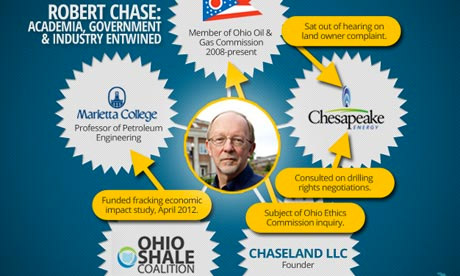 Moreover, in a feat of astounding hypocrisy, Shepstone attempts to discredit research he claims is supported by an organization that has no financial stake in the outcome of such research, while regularly echoing industry-friendly research and claims shaped by the very interests that have the most to gain from distorting information, the industry he really serves. Meanwhile, investigators have uncovered yet more instances of purportedly independent studies by academics connected to the for-profit fracking industry, as with reports that a University of Texas professor, Robert Chase -- whose studies claimed that "fracking was safe for groundwater" -- had allegedly "pocketed hundreds of thousands of dollars from a Texas natural gas developer."
Moreover, in a feat of astounding hypocrisy, Shepstone attempts to discredit research he claims is supported by an organization that has no financial stake in the outcome of such research, while regularly echoing industry-friendly research and claims shaped by the very interests that have the most to gain from distorting information, the industry he really serves. Meanwhile, investigators have uncovered yet more instances of purportedly independent studies by academics connected to the for-profit fracking industry, as with reports that a University of Texas professor, Robert Chase -- whose studies claimed that "fracking was safe for groundwater" -- had allegedly "pocketed hundreds of thousands of dollars from a Texas natural gas developer."
Shepstone has even attempted to defend his own bias by asserting that he held the same views about fracking before he started working on behalf of the industry. Such views are not created in a vacuum, however, and were likely shaped by the natural gas industry's PR machine for which he now works.
In his effort to smear Park and those concerned with fracking, Shepstone sidesteps the proliferation of non-profit groups that peddle pro-fracking claims, as exposed by Dory Hippauf. Beyond IPAA/EID, these include API (which has launched front groups called "Energy Citizens" and "EnergyNation"), the Marcellus Shale Coalition, the Ohio Shale Coalition, America's Natural Gas Alliance, the Center for Liquified Natural Gas, energy Tomorrow, EnergyfromShale.org, energyNow!, EnergyAnswered, LNGfacts.org, SecureOurFuels.org, Oilindependents.org, the Consumer Energy Alliance, Vote4Energy.org, the American Energy Alliance (AEA), the Institute for Energy Research (IER), and others.
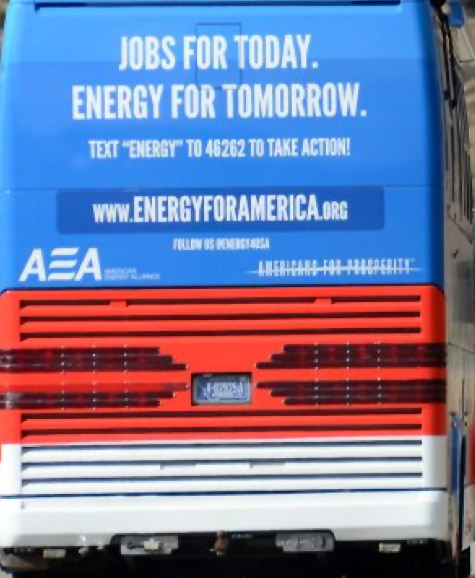 Some of these groups work together on campaigns. AEA, for example, joined in a bus tour with David Koch's Americans for Prosperity (AFP) to influence voters about fracking under the jobs frame frequently spouted by Shepstone. Due to inadequate public disclosure requirements, however, it is difficult to know who helped fund that tour besides Koch through his financial support for AFP, which he helped found and helps lead. This is just one of many ways pro-fracking groups coordinate and amplify common messages. They have even had overlapping public relations staff, as with IPAA/EID's Chris Tucker, a former GOP congressional staffer who has been described as a Senior Vice President at Financial Dynamics, as the "managing director of FTI Consulting and as team lead for Energy In Depth." For a time, Tucker was publicly listed as handling communications for both IPAA/EID and IER, "using the same phone number for both," according to DeSmogBlog's research.
Some of these groups work together on campaigns. AEA, for example, joined in a bus tour with David Koch's Americans for Prosperity (AFP) to influence voters about fracking under the jobs frame frequently spouted by Shepstone. Due to inadequate public disclosure requirements, however, it is difficult to know who helped fund that tour besides Koch through his financial support for AFP, which he helped found and helps lead. This is just one of many ways pro-fracking groups coordinate and amplify common messages. They have even had overlapping public relations staff, as with IPAA/EID's Chris Tucker, a former GOP congressional staffer who has been described as a Senior Vice President at Financial Dynamics, as the "managing director of FTI Consulting and as team lead for Energy In Depth." For a time, Tucker was publicly listed as handling communications for both IPAA/EID and IER, "using the same phone number for both," according to DeSmogBlog's research.
Of course, according to the leaked IPAA memo, one of the goals for EID was "coordinated messages."
But, Shepstone is relatively silent on such matters and on how his public messages help facilitate that goal.
Because entities like IPAA/EID, AEA, API, and AFP are not required to disclose their expenditures with the kind of detail that a grant-making foundation is, it is simply not possible to calculate the true amount of money these various non-profit groups are spending advancing the positions of the gas industry. Although their cumulative budgets amount to well over two hundred million dollars a year, the portion funded to support fracking or attack those concerned about fracking is unknown.
But it is clear that the Park Foundation is not a for-profit corporation that would benefit financially from the success of efforts to raise awareness about the risks of expanded fracking. Conversely, the multi-billion dollar corporations and/or some of the wealthy CEOs whose foundations fund organizations like IPAA/IED, CRC, and AFP do have a financial stake in advancing fracking with the least amount of regulation possible, regardless of what may be in the best interests of the public in protecting American families' health and their access to safe drinking water and clean air in the decades ahead.
After all, fracking is big business, as IPAA/EID's Shepstone regularly stresses.
The Center for Media and Democracy has received project grants from the Park Foundation that have allowed it to provide greater documentation of fracking issues, but this report was not funded or reviewed by the foundation. The analysis in this report reflects CMD's independent assessments as an expert critic of the techniques used in the field of public relations and propaganda. For nearly two decades, CMD has been a leading investigator of corporate-funded PR campaigns that affect our environment. Its most recent award-winning investigation is ALECexposed.org.
The author of this report, CMD's Executive Director Lisa Graves, received her J.D. from Cornell Law School, in Ithaca, New York. She previously served as Deputy Assistant Attorney General in the Office of Legal Policy at the U.S. Department of Justice, as the Chief Counsel for Nominations for the U.S. Senate Judiciary Committee, as the Deputy Chief of the Article III Judges Division of the U.S. Courts, and as an adjunct professor of law, among other posts.


Comments
Chip Northrup replied on Permalink
Energy in Depth
Wendy Lynne Lee replied on Permalink
Energy in Depth's Soldiers of Fracking-Fortune
Adriano replied on Permalink
Thanks